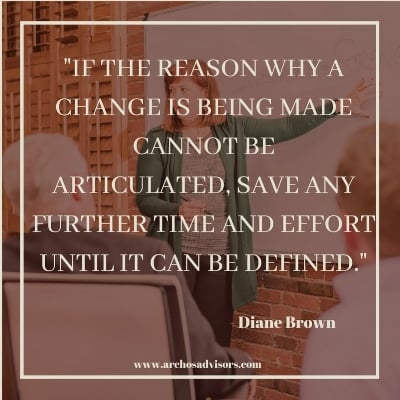
Organizations make decisions that create change every day, from structure, mergers, acquisitions, processes, technology, service models and methods, etc. It is what comes after the decision to change that determines the difference between success and failure.
To lay the foundation for success, start any change process with two questions:
1. From a business perspective, what specifically are you trying to achieve with the change (e.g., enhanced top line revenue, bottom line revenue, deeper relationships, expense control, quality, etc.)?
The leader or the leadership team heading up the change must define and agree upon the desired business outcomes. As they move through the change, these outcomes will be used to assess progress, and in the end, they will serve as the measurement of the ROI.
2. What percentage of these outcomes depend on people changing behaviors or actions as a part of their job?
To answer this question, we must first identify the impacted people or groups – anyone impacted by the change in any way. Second, consider what the individuals will have to change and how that relates to the desired outcomes. What happens if no one changes or very few do?

The answer to #1 provides the context – the WHY. Why are the change being made? If you can’t answer #1, it’s not clear, or leadership is not committed, stop right there. If the reason why a change is being made cannot be articulated, save any further time and effort until it can be defined.
If the “why” is clear, then #2 is critical. If the change is one where business outcomes are highly dependent on people changing behavior (i.e., 60, 80, 100%), then consideration of how to implement intentional change management must be made.
Change management proactively addresses the people side of the change, helping people move from the current state, through a transition state, to the desired future state. It includes applying a scientific approach to the psychology involved in change. When coupled with project management (i.e., technical processes, project charter, timelines, budget, resources, etc.), change management promotes higher realization of business outcomes.
The next time you are embarking on an organizational change, set yourself up for success. Ask these two questions, and use the answers to guide to your strategy. If you do, you will have a solid foundation for change, and it’s much more likely that you will achieve your desired results.
